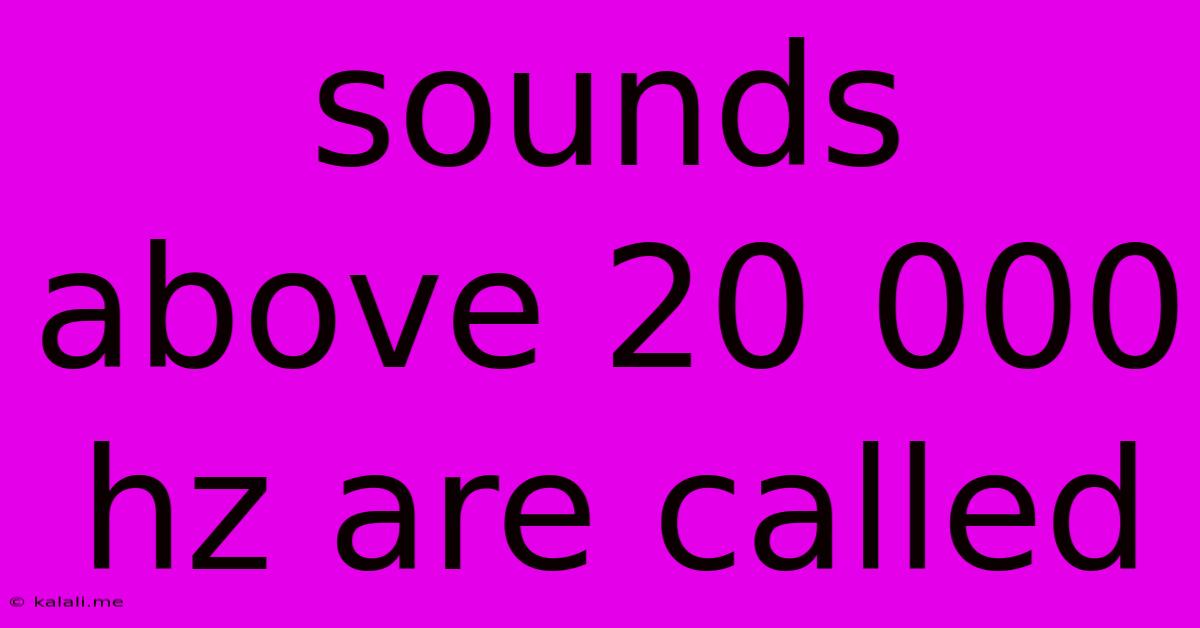Sounds Above 20 000 Hz Are Called
Kalali
Jun 16, 2025 · 3 min read

Table of Contents
Sounds Above 20,000 Hz Are Called Ultrasound: Exploring the World of High-Frequency Sound
Meta Description: Discover the fascinating world of ultrasound! Learn what sounds above 20,000 Hz are called, their properties, and their diverse applications in medicine, technology, and beyond.
Sounds above 20,000 Hz are called ultrasound. This frequency range lies beyond the upper limit of human hearing, which typically extends to around 20,000 Hz (20 kHz). While we can't hear ultrasound, it's a powerful and versatile form of energy with numerous applications across various fields. This article delves into the characteristics of ultrasound and explores its significant uses.
Understanding Ultrasound: Frequency and Properties
The term "ultrasound" refers to acoustic vibrations with frequencies exceeding the audible range for humans. These high-frequency sound waves possess unique properties that differentiate them from audible sound. Their shorter wavelengths allow for greater precision in imaging and targeting specific areas. Furthermore, ultrasound waves can interact differently with various materials, allowing for their application in diverse technological advancements. This interaction, often involving reflection and absorption, forms the basis for many ultrasound imaging techniques.
Specific properties of ultrasound relevant to its applications include:
- High frequency: Leads to shorter wavelengths enabling high-resolution imaging and precise targeting.
- Absorption and reflection: These properties are crucial for creating images in medical ultrasound scans and for other industrial applications.
- Energy transmission: Ultrasound can transmit significant energy, utilized in therapeutic applications such as physiotherapy and certain medical treatments.
- Non-ionizing nature: Unlike X-rays, ultrasound waves are non-ionizing, meaning they don't carry enough energy to damage DNA and cause harm in the same way. This makes it relatively safe for various medical procedures.
Applications of Ultrasound
The applications of ultrasound are extensive and continue to expand. Here are some key areas where ultrasound technology plays a crucial role:
1. Medical Imaging: This is arguably the most well-known application. Ultrasound imaging (sonography) uses high-frequency sound waves to create images of internal organs and tissues. It's a non-invasive and relatively inexpensive technique used for diagnosing a wide range of medical conditions, from pregnancy monitoring to detecting internal bleeding. Different types of ultrasound, such as Doppler ultrasound, provide additional information like blood flow velocity.
2. Medical Therapy: Therapeutic ultrasound uses focused sound waves to deliver energy to specific tissues. This can be used for physiotherapy to treat muscle injuries, and in more advanced procedures for targeted drug delivery and even the destruction of cancerous tissue.
3. Industrial Applications: Ultrasound finds applications in various industrial processes, including non-destructive testing (NDT) of materials to detect flaws, cleaning and degreasing parts, and even welding. Ultrasonic sensors are used in various applications for measuring distance and detecting objects.
4. Animal and Marine Research: Ecolocation in bats and dolphins involves emitting ultrasonic sounds and using the echoes to navigate and hunt. Scientists are inspired by these natural examples for developing technology, particularly in the field of robotics and autonomous systems.
5. Other Applications: From pest control to enhancing oil extraction and air pollution monitoring, ultrasound technology proves increasingly versatile and innovative.
Beyond the Audible: Exploring the Spectrum
Understanding ultrasound opens up a world of possibilities, revealing a frequency range rich in scientific and technological applications that far surpass our auditory capabilities. The continued development and refinement of ultrasound technology promise even more innovative uses in the future. From medical breakthroughs to advancements in industrial processes, the ability to harness and manipulate these high-frequency sound waves holds immense potential.
Latest Posts
Latest Posts
-
How To Create Clickable Image In Html
Jun 16, 2025
-
What Are The Factors Of 121
Jun 16, 2025
-
What Is A Theme Of The Passage
Jun 16, 2025
-
A Company That Provides Access To The Internet
Jun 16, 2025
-
Which Word Is Closest In Meaning To The Underlined Word
Jun 16, 2025
Related Post
Thank you for visiting our website which covers about Sounds Above 20 000 Hz Are Called . We hope the information provided has been useful to you. Feel free to contact us if you have any questions or need further assistance. See you next time and don't miss to bookmark.